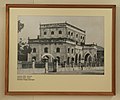File:Shamaldas College Old Building - Bhavnagar.jpg
- Anonymous works, photographs, cinematographic works, sound recordings, government works, and works of corporate authorship or of international organizations enter the public domain 60 years after the date on which they were first published, counted from the beginning of the following calendar year (i.e. as of 2024, works published prior to 1 January 1964 are considered public domain).
- Posthumous works (other than those above) enter the public domain after 60 years from publication date, counted from the beginning of the following calendar year.
- Any kind of work other than the above enters the public domain 60 years after the author's death (or in the case of a multi-author work, the death of the last surviving author), counted from the beginning of the following calendar year.
- Text of laws, judicial opinions, and other government reports are free from copyright.

|
This reproduction is permitted under the Indian Copyright Act of 1957, Section 52, which states:
Note that this does not include copies of paintings, drawings, or photographs, as they do not fall under the referenced sub-clause (iii). They fall under sub-clause (i).
Indian law is modelled on UK law, and in the absence of any specific case law to the contrary it is reasonable to assume that the rules will be similar. See the United Kingdom section for more details. See COM:CRT/India#Freedom of panorama for more information.
|

